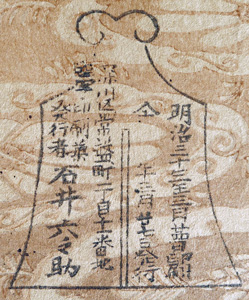About This Print
Published on March 27, 1900, six weeks before the wedding ceremony of twenty-one year old Crown Prince Yoshihito to sixteen year old Kujō Sadako, daughter of Duke Michitaka Kujō, head of Kujō branch of the Fujiwara clan, this triptych portrays an unnamed ceremony being conducted at the Imperial Palace with the crown prince, his bride to be, the emperor and empress and military officials in attendance. Three court ladies are seated before the crown prince.The Historical Context of the Print
Source: website of the Spencer Museum of Art, University of Kansas http://www.spencerart.ku.edu/exhibitions/divine-inspiration/miller-noble.shtml
A Variant PrintingThe year Meiji 33 was important for the Japanese Imperial Family, as it marked the wedding ceremony of the Meiji Emperor’s son and successor, Crown Prince Yoshihito. The wedding took place on the 10th day of the 5th month, but prior to the ceremony, many smaller formal events took place. As documented in Donald Keene’s 2002 biography of the sovereign, Emperor of Japan: Meiji and His World, on March 23, the date of this print, the crown prince underwent health examinations to insure his physical health was strong enough for marriage. Yoshihito endured serious illness only five years earlier, and experienced a difficult recovery. His doctors and the court entourage determined on March 23 that he was indeed fit for marriage, and this print may be related to this decision. The marriage and expectation of subsequent children was important to carrying on the unbroken imperial lineage, which many traced to the Sun Goddess Amaterasu, and as such the event may have called for a ritual marking the preparation for the passage of both religious and political rule to the crown prince. Various court ceremonies, such as the one that this image presents, were newly fabricated during the Meiji period, and their public display was an innovation of the modern era. As the state attempted to gain the support of the populace, court rites and rituals, as well as publicly distributed images and descriptions of them, were intended to arouse national pride, unity, and a loyalty to the crown. In addition to court images, bunmei kaika-e, or “pictures of civilization and enlightenment,” presented modern brick buildings, iron bridges, and newly constructed railroads as evidence of a successful government and theocracy. All of this imagery worked in tandem to fashion an image of nationalism under the watchful and protective eye of the emperor.
1 Emperor of Japan: Meiji and His World, 1852-1912, Donald Keene, Columbia University Press, 2002, p. 553.
2 Splendid Monarchy: Power and Pageantry in Modern Japan, T. Fujitani, University of California Press, 1998, p. 118.
Print Details
| IHL Catalog | #1100 |
| Title | Illustration of Noble’s Imperial Ceremony [Illustration of Grand Ceremony of Accession of a High Rank] 高位御大禮之図 Kōi godairei no zu |
| Artist | Watanabe Nobukazu (1872-1944) |
| Signature |  応需 延一画 ōju Nobukazu ga |
| Seal | Yōsai 楊斎 (see above) |
| Publication Date | 1900 March 27 |
| Publisher | Ishii Rokunosuke 石井六乃助 [Marks: pub. ref. 160; seal not shown] reading from right to left: 明治三十三年三月廿四日印刷 [Meiji 33 3rd month 24th day printed] 仝年三月廿七日発行 [Meiji 33 3rd month 27th day published] [publisher's address] 印刷兼 発行者 石井六乃助 [printed and published Ishii Rolunosuke] |
| Impression | excellent |
| Colors | excellent |
| Condition | good - full size separate sheets, unbacked, minor wrinkling on right panel; minor damage repair verso |
| Genre | ukiyo-e; kaika-e |
| Miscellaneous | |
| Format | vertical oban triptych |
| H x W Paper | 14 11/16 x 9 3/4 in. (37.3 x 24.8 cm) each panel |
| H x W Image | 14 5/16 x 9 1/2 in. (36.4 x 24.1 cm) each panel |
| Literature | |
| Collections This Print | Spencer Museum of Art, The University of Kansas 2002.0205 a,b,c |




